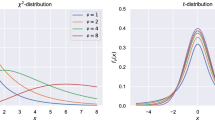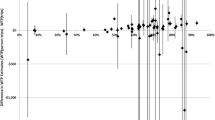Abstract
We obtain confidence intervals for willingness-to-pay (WTP) measures derived from a mode choice model estimated to analyse travel demand for suburban trips in the two main interurban corridors in Gran Canaria using a mixed RP/SP data base. We considered a specification of the systematic utility that incorporates income effect, and interactions among socioeconomic variables and level-of-service attributes, as well as between travel cost and frequency. As our model provides rather complex expressions of the marginal utilities, we simulated the distribution of the WTP (in general, unknown) from a multivariate Normal distribution of the parameter vector. For every random draw of the parameter vector, the corresponding simulation of the WTP was obtained applying the sample enumeration method to the individuals in the RP database. The extremes of the confidence interval were determined by the percentiles on this distribution. After trying different simulation strategies we observed that the size of the intervals was strongly affected by the outliers as well as by the magnitude of the simulated parameters. In all cases examined the simulated distribution of the corresponding WTP measure presents an asymmetric shape that was very similar for the two model specifications considered. This is consistent with previous findings using a radically different approach. We also observed that the upper extreme of the confidence interval for the value of time in private transport was very unstable for different numbers of random draws.
Similar content being viewed by others
References
Armstrong P, Garrido R, Ortúzar J de D (2001) Confidence intervals to bound the value of time. Transp Res E 37:143–161
Ben-Akiva M, Lerman SR (1985) Discrete choice analysis: theory and application to travel demand. MIT, Cambridge, Massachusetts
Ben-Akiva ME, Morikawa T (1990, July) Estimation of travel demand models from multiple data sources. Proceedings 11th International Symposium on Transportation and Traffic Theory, Yokohama
Bradley MA, Daly AJ (1997) Estimation of logit choice models using mixed stated preference and revealed preference information. In: Stopher PR, Lee-Gosselin M (eds.), Understanding travel behaviour in an era of change, Pergamon, Oxford
Espino R, Román C, Ortúzar J de D (2004) Diseño de preferencias declaradas para analizar la demanda de viajes. Estudios de Economía Aplicada 22:1–33 (in Spanish)
Espino R, Román C, Ortúzar J de D (2006) Analysing demand for suburban trips: a mixed RP/SP model with latent variables and interaction effects. Transportation 33:241–261
Ettema D, Gunn H, De Jong G, Lindveld K (1997) A simulation method for determining the confidence interval of a weighted group average value of time. Proceedings 25th European Transport Forum, Brunel University, England
Galvez T, Jara-Díaz SR (1998) On the social valuation of travel time savings. Int J Transp Econ 25:205–219
Garrido, RA, Ortúzar J de D (1993). The Chilean value of time study: methodological developments. Proceedings 21st PTRC Summer Annual Meeting, University of Manchester Institute of Science and Technology, England
Jara-Díaz SR (1990) Consumer's surplus and the value of travel time savings. Transp Res 24:73–77
Jara-Díaz SR (1998) Time and income in travel choice: towards a microeconomic activity-based theoretical framework. In: Garling T, Laitila T, Westin K(eds.), Theoretical foundations of travel choice modelling. Elsevier Science, New York
Jara-Díaz SR, Videla J (1989) Detection of income effect in mode choice: theory and application. Transp Res B 23:393–400
Jara-Díaz SR, Gálvez T, Vergara C (2000) Social valuation of road accident reductions using subjective perceptions. J Transp Econ Policy 34:215–232
Lancsar E, Savage E (2004a) Deriving welfare measures in discrete choice experiments: inconsistency between current methods and random utility and welfare theory. Health Econ 13:901–907
Lancsar E, Savage E (2004b) Deriving welfare measures in discrete choice experiments: a response to Ryan and Santos Silva. Health Econ 13:919–924
Louviere JJ, Hensher DA, Swait JD (2000) Stated choice methods: analysis and application. Cambridge University Press, Cambridge
McFadden D (1981) Econometric models of probabilistic choice. In: Manski C, McFadden D (eds) Structural analysis of discrete data: with econometric applications. MIT, Cambridge, Massachusetts
Ortúzar J de D, Willumsen LG (2001) Modelling Transport 3rd edition, Wiley, Chichester
Ryan M (2004) Deriving welfare measures in discrete choice experiments: a comment to Lancsar and Savage (I). Health Econ 13:909–912
Santos Silva JMC (2004) Deriving welfare measures in discrete choice experiments: a comment to Lancsar and Savage (II). Health Econ 13:913–918
Small KA, Rosen HS (1981) Applied welfare economics with discrete choice models. Econometrica 49:105–130
Train KE (2003) Discrete choice methods with simulation. Cambridge University Press, Cambridge
Williams HCWL (1977) On the formation of travel demand models and economic evaluation measures of user benefit. Environ Plan A9:167–219
Author information
Authors and Affiliations
Corresponding author
Rights and permissions
About this article
Cite this article
Espino, R., de Dios Ortúzar, J. & Román, C. Confidence Interval for Willingness to Pay Measures in Mode Choice Models. Netw Spat Econ 6, 81–96 (2006). https://doi.org/10.1007/s11067-006-7694-3
Published:
Issue Date:
DOI: https://doi.org/10.1007/s11067-006-7694-3




